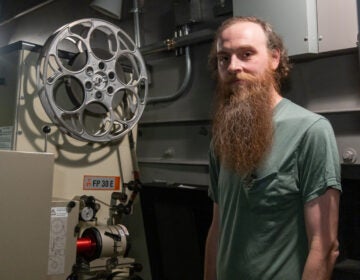From Theatre Exile: Is ‘An Oak Tree’ real or artificial?
Gimmickry overtakes a play bombarded by on-stage directions and a prescribed lack of rehearsal.

Pearce Bunting as a hypnotist in "An Oak Tree," produced by Theatre Exile.
Before I get into the confused and confusing piece of theater called “An Oak Tree,” let’s consider the most satisfying aspect of the production: its location. Theatre Exile in South Philadelphia, at Reed and 13th Streets, is now in its newly built home, still slightly under construction but ready for performances.
The space hasn’t been renovated as much as rethought, repurposed and rebuilt. Everything — even the box office — is movable if needed, as I learned when Exile’s producing artistic director Deborah Block showed me some of the theater’s features. These include a sprung floor for dance and physical theater, covering the entire black-box auditorium. Risers for seating can be arranged any way directors and designers see fit. A balcony sweeps along two walls — it’s mostly for people involved in a show but not on stage. There are wings off the stage and a small rehearsal space. The new seats can be moved to fit the riser arrangements — they’re practical but not so comfortable.
None of the new theater’s useful features could be found formerly in the same space, which Exile had been using. Theater, of course, happens wherever it is made, so in that dumpy old space I spent many evenings enthralled by Theatre Exile’s work, which often spotlights risky plays the stage company celebrates with gripping productions.
I wish I could tell you that “An Oak Tree,” Exile’s inaugural production in its new space, is one of them. But I won’t mince words: It’s a stunningly ill-wrought piece of theater, and the production Exile gives the play is probably the best anyone could expect. The British playwright Tim Crouch, who focuses on what everyone once called “experimental theater” until that phrase became a catchword for “iffy,” wrote “An Oak Tree” with a great idea in mind. He explored the way one father deals with loss and grief by transferring the presence and soul of his dead daughter to an oak tree near the roadside accident that killed her.
Deep, right? And ripe with dramatic possibility. But Crouch has gimmicked up his two-hander plot with conceits that overwhelm the story, shoving it to the background. One of these calls for a single actor throughout the run of the production to portray a hypnotist who drives the deadly vehicle, and a new actor each performance to play the grieving father. That actor, it is said, knows nothing about the play, giving it a cold read in front of the audience. (This has been done with mixed results in plays by the Iranian writer Nassim Soleimanpour, one running now Off-Broadway.)
In “An Oak Tree,” Theatre Exile’s production boasts 22 different “second actors,” as they’re called — one for each of the performances, to team with the formidable Pearce Bunting, a Philadelphia native who lives in Minnesota. Bunting has taken many roles with Exile, played on Broadway in “Mamma Mia!” and on TV’s “Boardwalk Empire.” Here, he’s a hypnotist-entertainer with the sensibility of a lounge lizard, putting people under his spell for audiences. During one of his performances, he meets up with the father of the girl he killed.
Over the weekend, the father I saw was played cautiously but gamely by Zosia Mamet, of TV’s “Mad Men” and “Girls.” I use the term “played” loosely, because neither actor gets a chance to mold a character into anything more than an idea. “An Oak Tree” is filled with action that breaks the story. Bunting gives cues and stage directions, and sometimes lines, to the second actor. Scenes are short, broken while Bunting moves to a long table to pick up yet another clipboard holding the script of a new scene, or directs the actor to sit like this or respond like that. The second actor reads, presumably for the first time, from the clipboards.
Given all this, how can anyone build a dramatic arc? I sat in the audience feeling badly for the actors and for the founder of Theatre Exile, Joe Canuso, tasked with directing a play that seems like a misguided exercise created by and for average theater students. Whenever the underdeveloped story burst into something like a dramatic turn, my thought was “Where did that emotion come from?” It all seems artificial, dented by staging details that suck the air out of the evening. “An Oak Tree” has a story, sure. But the story becomes one about the process of putting on a play and for that, someone can invite us to look in on an early rehearsal. Not a performance night.
—
“An Oak Tree” runs through March 10 at Theatre Exile, 13th and Reed Streets. 215-218-4022 or theatreexile.org.
WHYY is your source for fact-based, in-depth journalism and information. As a nonprofit organization, we rely on financial support from readers like you. Please give today.




